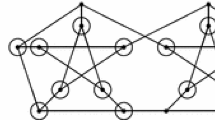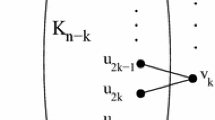Abstract
For a graph H, let \(\alpha (H)\) and \(\alpha ^{\prime }(H)\) denote the independence number and the matching number, respectively. Let \(k\ge 2\) and \(r>0\) be given integers. We prove that if H is a k-connected claw-free graph with \(\alpha (H)\le r\), then either H is Hamiltonian or the Ryjá c̆ ek’s closure \(cl(H)=L(G)\) where G can be contracted to a k-edge-connected \(K_3\)-free graph \(G_0^{\prime }\) with \(\alpha ^{\prime }(G_0^{\prime })\le r\) and \(|V(G_0^{\prime })|\le \max \{3r-5, 2r+1\}\) if \(k\ge 3\) or \(|V(G_0^{\prime })|\le \max \{4r-5, 2r+1\}\) if \(k=2\) and \(G_0^{\prime }\) does not have a dominating closed trail containing all the vertices that are obtained by contracting nontrivial subgraphs. As corollaries, we prove the following:
-
(a)
A 2-connected claw-free graph H with \(\alpha (H)\le 3\) is either Hamiltonian or \(cl(H)=L(G)\) where G is obtained from \(K_{2,3}\) by adding at least one pendant edge on each degree 2 vertex;
-
(b)
A 3-connected claw-free graph H with \(\alpha (H)\le 7\) is either Hamiltonian or \(cl(H)=L(G)\) where G is a graph with \(\alpha ^{\prime }(G)=7\) that is obtained from the Petersen graph P by adding some pendant edges or subdividing some edges of P.
Case (a) was first proved by Xu et al. [19]. Case (b) is an improvement of a result proved by Flandrin and Li [12]. For a given integer \(r>0\), the number of graphs of order at most \(\max \{4r-5, 2r+1\}\) is fixed. The main result implies that improvements to case (a) or (b) by increasing the value of r and by enlarging the collection of exceptional graphs can be obtained with the help of a computer. Similar results involved degree or neighborhood conditions are also discussed.





Similar content being viewed by others
References
Berge, C.: Sur le couplage maximum d’un graphe. CR Acad. Sci. Paris 247, 258–259 (1958)
Bondy, J.A., Murty, U.S.R.: Graph Theory. Springer, New York (2008)
Catlin, P.A.: A reduction method to find spanning Eulerian subgraphs. J. Graph Theory 12, 29–45 (1988)
Catlin, P.A., Han, Z., Lai, H.-J.: Graphs without spanning closed trails. Discrete Math. 160, 81–91 (1996)
Chen, Z.H.: Degree and neighborhood conditions for hamiltonicity of claw-free graphs (submitted)
Chen, W.-G., Chen, Z.-H.: Spanning Eulerian subgraphs and Catlin’s reduced graphs. J. Combin. Math. Combin. Comput. (2014) (accepted)
Chen, Z.-H.: Spanning closed trails in graphs. Discrete Math. 117, 57–71 (1993)
Chen, Z.-H., Lai, H.-J.: Collapsible graphs and matching. J. Graph Theory 17, 597–605 (1993)
Chen, Z.-H., Lai, H.-J., Zhang, M.: Spanning trails with variations of Chvátal–Erdös conditions (submitted)
Chvátal, V., Erdös, P.: A note on Hamiltonian circuits. Discrete Math. 2, 111–113 (1972)
Faudree, R.J., Gould, R.J., Jacobson, M.S., Lesniak, L.M., Lindquester, T.E.: On independent generalized degrees and independence numbers in \(K(1, m)\)-free graphs. Discrete Math. 103(1), 17–24 (1992)
Flandrin, E., Hao Li.: Chvátal–Erdós condition in 3-connected claw-free graphs, Papport de Recherche L. R. I. No. 500, University of Paris-Sud, Orsay (1989)
Harary, F., Nash-Williams, CStJA: On Eulerian and Hamiltonian graphs and line graphs. Can. Math. Bull. 8, 701–710 (1965)
Roussopoulos, N.D.: A max\(\{m, n\}\) algorithm for determining the graph \(H\) from its line graph \(G\). Info. Process. Lett. 2, 108–112 (1973)
Ryjáček, Z.: On a closure concept in claw-free graphs. J. Combin. Theory Ser. B 70, 217–224 (1997)
Shao, Y.: Claw-free graphs and line graphs, Ph.D dissertation, West Virginia University (2005)
Tutte, W.T.: The factorization of linear graphs. J. Lond. Math. Soc. 22, 107–111 (1947)
Veldman, H.J.: On dominating and spanning circuits in graphs. Discrete Math. 124, 229–239 (1994)
Xu, J., Li, P., Miao, Z., Wang, K., Lai, H.J.: Supereulerian graphs with small matching number and 2-connected hamiltonian claw-free graphs. Int. J. Comput. Math. 91, 1662–1672 (2014)
Author information
Authors and Affiliations
Corresponding author
Additional information
Research is supported by Butler University Academic Grant (2015).
Rights and permissions
About this article
Cite this article
Chen, ZH. Chvátal–Erdös Type Conditions for Hamiltonicity of Claw-Free Graphs. Graphs and Combinatorics 32, 2253–2266 (2016). https://doi.org/10.1007/s00373-016-1716-9
Received:
Revised:
Published:
Issue Date:
DOI: https://doi.org/10.1007/s00373-016-1716-9




